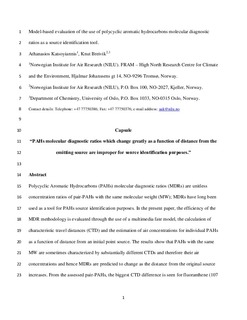| dc.contributor.author | Katsoyiannis, Athanasios | |
| dc.contributor.author | Breivik, Knut | |
| dc.date.accessioned | 2017-12-04T11:59:27Z | |
| dc.date.available | 2017-12-04T11:59:27Z | |
| dc.date.created | 2013-10-17T13:12:31Z | |
| dc.date.issued | 2014 | |
| dc.identifier.citation | Katsoyiannis, A., Breivik, K. (2014). Model-based evaluation of the use of polycyclic aromatic hydrocarbons molecular diagnostic ratios as a source identification tool. Environmental Pollution, 184, 488-494. doi:10.1016/j.envpol.2013.09.028 | nb_NO |
| dc.identifier.issn | 0269-7491 | |
| dc.identifier.uri | http://hdl.handle.net/11250/2469001 | |
| dc.description.abstract | Polycyclic Aromatic Hydrocarbons (PAHs) molecular diagnostic ratios (MDRs) are unitless concentration ratios of pair-PAHs with the same molecular weight (MW); MDRs have long been used as a tool for PAHs source identification purposes. In the present paper, the efficiency of the MDR methodology is evaluated through the use of a multimedia fate model, the calculation of characteristic travel distances (CTD) and the estimation of air concentrations for individual PAHs as a function of distance from an initial point source. The results show that PAHs with the same MW are sometimes characterized by substantially different CTDs and therefore their air concentrations and hence MDRs are predicted to change as the distance from the original source increases. From the assessed pair-PAHs, the biggest CTD difference is seen for Fluoranthene (107 km) vs. Pyrene (26 km). This study provides a strong indication that MDRs are of limited use as a source identification tool. | nb_NO |
| dc.language.iso | eng | nb_NO |
| dc.rights | Attribution-NonCommercial-NoDerivatives 4.0 Internasjonal | * |
| dc.rights.uri | http://creativecommons.org/licenses/by-nc-nd/4.0/deed.no | * |
| dc.title | Model-based evaluation of the use of polycyclic aromatic hydrocarbons molecular diagnostic ratios as a source identification tool | nb_NO |
| dc.type | Journal article | nb_NO |
| dc.type | Peer reviewed | nb_NO |
| dc.description.version | acceptedVersion | nb_NO |
| dc.rights.holder | © 2013 Elsevier Ltd. All rights reserved. | nb_NO |
| dc.source.pagenumber | 488-494 | nb_NO |
| dc.source.volume | 184 | nb_NO |
| dc.source.journal | Environmental Pollution | nb_NO |
| dc.identifier.doi | 10.1016/j.envpol.2013.09.028 | |
| dc.identifier.cristin | 1058441 | |
| dc.relation.project | Andre: Norwegian Climate and Pollution Agency (KLIF) | nb_NO |
| dc.relation.project | Norges forskningsråd: 213577 | nb_NO |
| cristin.unitcode | 7460,60,0,0 | |
| cristin.unitcode | 7460,57,0,0 | |
| cristin.unitname | Miljøkjemi | |
| cristin.unitname | Atmosfære og klima | |
| cristin.ispublished | true | |
| cristin.fulltext | postprint | |
| cristin.qualitycode | 1 | |

